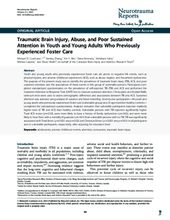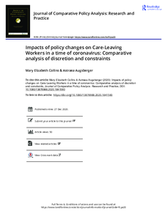Displaying 431 - 440 of 2502
"While Pennsylvania has made great strides in ensuring family preservation, placement with kin and the maintenance of kinship connections, there is an opportunity to identify strategies to increase these outcomes and become a national leader in putting families first," this report argues. The paper outlines concrete policy solutions that "can improve this trajectory, making Pennsylvania a model for other states [in the U.S.]."
The purpose of the present study was to identify the prevalence of traumatic brain injury (TBI), adverse childhood experiences (ACE), and poor sustained attention and the associations of these events in youth and young adults who previously experienced foster care.
This study examines whether former foster youth are more likely to stop out of a 4-year university than low-income, first-generation students who did not experience out-of-home care.
This study sought to validate the Early TRAuma-related Disorders Questionnaire (ETRADQ), a caregiver report which was developed to assess attachment disorders in school-age children based on the Diagnostic and Statistical Manual of Mental Disorders–Fifth edition criteria.
The objective of this study was twofold: to explicate how a culturally adapted parent training (PT) intervention for diverse families involved in child welfare services (CSW) was perceived by participants and to better understand how interventionists adapted to families’ needs.
"Experts and state agencies say families are reluctant to take in foster children for fear of spreading Covid-19," says this article from NBC News.
This study analyzed three open-ended responses from a national online survey examining compassion fatigue in Children’s Advocacy Centers (CACs) to understand the impact of work-related stress on child welfare workers (CWWs).
This policy analysis examines the impact of COVID-19 policy guidance on the role of workers who provide outreach to transition-age care leavers.
This study investigates the extent and causes of child abandonment and various practices and services in relation to prevention of child abandonment in Denmark and other high-income countries.
This article describes the benefits of monthly family team meetings for parents involved with child welfare. Findings are shared from semi‐structured, qualitative interviews conducted with 17 parents whose children had been placed in substitute care.




